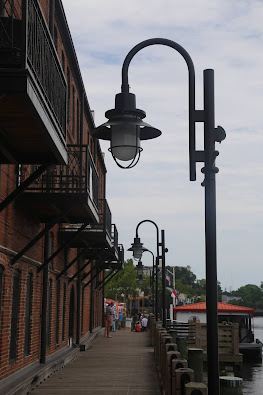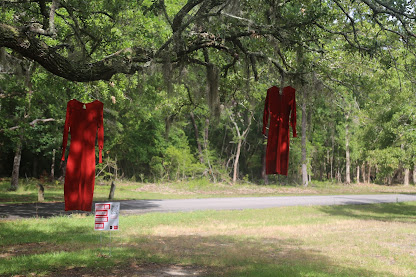Day 5
Saturday, June 5
For the first time in days, the sun was out when I woke up. With no rush, I rolled out of the motel at 9A and headed towards the ferry to Fort Fisher. I paid my $7 and the friendly woman at the gate assured me the line was short enough I’d make the 9:15A, which was already starting to board.
With perfect conditions, we were off for the forty minute ride to Fort Fisher.
When you land, you can either take the left toward the fort, or a right to the side of Battery Buchanan and a small beach. This was the first line of defense for the fort, which in turn was the first line of defense for Wilmington.
The Confederate battery fired on and hassled any Union ship that got too close. It was also the fallback position if the main fort should fall. However, when it was clear they couldn't hold, Genera Whiting led his defenders to this point, only to find no one left, and the canon spiked. He waved the white flag and surrendered.
My sister Maggie recently bought a place in Wilmington and offered to let me stay. Unfortunately, she’s still in Jersey, so we couldn’t hang out. But, I was truly grateful. It was so nice not to be in a motel for a few nights.
The roadtrip craving for Pizza was starting to kick in, so I did what I always do. I do a search for what’s been “voted best pizza.” It rarely goes wrong. This led me to a place called Slice of Life, in the heart of the historic district, and two blocks from the Cape Fear River.
Across the river from downtown sits the USS North Carolina. After World War II, the battleship was decommissioned and eventually headed to the scrapyard. A statewide campaign to save the ship began, and in 1961 it was brought here. They do offer tours of the ship. I took it once as a kid, and again maybe ten years ago. I even considered a revisit.
On the riverwalk, I came across this sculpture of a Venus Flytrap by artists Paul Hill and Stan Harmon. The plaque below says it's only indigenous to the swamps in this part of North Carolina, and was declared the official State Carnivorous Plant.
On the far end sits the Cape Fear River Bridge. It opened when I was a little kid. I don't remember much about it, but I do remember it was open to pedestrians one day before it opened for cars. My family walked across. It was pretty cool for a kid. And yeah, as an adult, it would still be pretty cool.
After the post lunch walk along the river, it was time to check out one of Wilmington’s numerous breweries. Waterline Brewery claims to be “right under the bridge.” It seemed the perfect place to start.
The place was pretty empty when I pulled in, so I parked in the very back of the lot. Little did I know what was in store.
I was there for a while, watching the place slowly fill, the line at the bar now out the door and the noise level getting a bit much. It was time to head back out.
Once outside, there was a band playing. A dozen or so tables had appeared out of nowhere. There were people selling local craftwork. There were also numerous displays from organizations trying to clean up the river. In the back of the lot, there was even a taco truck parked next to my car, with a line.
I started talking with one group who have designed some devices they’re placing in the river that simply filter debris. Imagine a bright yellow barrel. On the bottom is what amounts to a propeller. This causes the water to flow through the barrel, collecting debris in filters. They dump them every two days. It seemed like such an easy design, yet still fascinating.
When some random guy says, "hey, take my picture..."
Before I left, I even found myself in a conversation with one of the city councilmen, and he told me about some of the big projects the city has in store. Since Wilmington has a thriving port, it also means freight trains run back and forth. So, the city is spending money to build some bridges and reroute a few lines, so they don't disrupt traffic.
With more and more people flowing in, it was time to go. I walked up to the line at the taco truck and asked for some help getting my car through the line and down the driveway. It suddenly turned into a big group effort. Maybe it was the beer, but everyone seemed happy to help.

































































